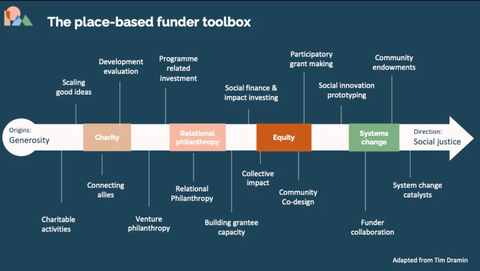Place-based working : More than the sum of its parts through building fields of practice

We have always existed in a fragmented landscape in civil society. Whether money comes from government or philanthropy, it is bounded by the specific purpose and interest of the funder and the job of civil society has been to attract that funding into communities mostly through a competitive process and mostly in relatively small and short-term pots. Inevitably there are winners and losers and as we look at the landscape there are significant geographic hot and cold spots that don’t correspond to relative need, but reflect the strength of the local charity sector. Whilst many programmes have sought to join up work across communities, the impact of the work is bounded by a duration of funding rather than achieving a sustainable ambition for change.
That’s not to say the practice of funding and delivering local change hasn’t developed. There has been and continues to be a significant shift towards thinking and working systematically in place. Coming with it the many challenges of establishing inclusive and low-ego governance structures, of empowering communities to lead or participate equally in creating change and the more pedestrian but very significant challenge of making space and time for collective and collaborative working in a time poor public service environment. These remain aspirations with too few as yet bright spots of practice to inspire and inform others.
But, and it is a big but, creating systemic collaborations in place is only part of the story of achieving systems change. All significant systemic challenges are rooted at different levels. By working at place, we see the system at a human level, the different ways that the system impact on and interacts with people. We can make sense of the differences and intervene in the way the system interacts to make it more equitable. We see how the system more widely might be better designed for all, but the trade off is that community-level projects by definition lack the wider reach and influence beyond place.
So, we need another dimension to the work that supports communities to lever change and one that doesn’t weaken the principles of community-led systemic working. Looking beyond the UK we are seeing the emergence of a practice termed Field Building that we think may have some of the answers and this blog seeks to explain why.
What is a Field and what is Field Building?
Field Building is a term coined by Bridgespan Group in the US. In their work advising and commenting on the development of philanthropy in the US they noticed a new form of organisation emerging. Sometimes coming from existing civil society organisations, sometimes being created to catalyse a specific change, Field Building spans the spaces between those doing the work and those influencing or campaigning for wider change.
Many funders seeking to create population-level change are finding that scaling individual organizations isn’t enough. It takes meaningful, intentional coordination across a social change field’s actors — field building — to spark change on a massive scale. Bridgespan Group*
A Field is defined by a shared ambition or “northstar” where there are common challenges and a shared systemic challenge to be tackled. Field Building is the activity and capability that joins people and organisations together to make that wider change happen.
To start, we define a “field” as a set of individuals and organizations working to address a common social issue or problem, often developing and using a common knowledge base. We define “field building” as the activities or investments that drive a field’s progress toward impact at scale. Bridgespan Group*
Taking a place lens on field building, it is about connecting communities to a broader coalition of voices and amplifying the influence of those voices and experiences by gathering knowledge collectively and using the strength of the collective to influence change.
As we have learned from the Collective Impact model, having a backbone organisation to drive collective efforts is critical. Similarly, in building a Field, the collective efforts across communities and organisations to change a Field needs its own form of backbone, or catalyst. The Field Building Catalyst is a visible leader holding the collective voice, a field expert with deep subject matter knowledge and campaigner with a clear agenda, as well as convening the actors and creating the conditions through which change can happen.
Place Matters is part of a global coalition of organisations including Tamarack Institute (Canada), Collective Impact Forum (US), Collaboration for Impact (Australia) and Inspiring Communities (New Zealand). Most of those partners are already involved in developing the practice of Field Building in some way and there are some inspiring examples of how it is achieving impact. For example the Vibrant Communities programme made up of [800] communities tackling poverty have influenced federal policy in Canada. In Australia Collaboration for Impact work with indigenous communities through a programme called Deep Collaboration aimed at shifting the national narrative following the recent referendum vote. Bringing together communities and decision-makers each year through an annual event — Changefest, they influence change by showing the work of communities to those in power and creating space for dialogue.
How to fund Field Building?
The question of how to fund Field Building is an important early consideration because philanthropy is instrumental in creating the conditions through which civil society works. Many philanthropic organisations are already well along on a journey from traditional charity to driver of social justice. This visual adapted from an original piece by Tim Draimin captures the evolution.

Field building creates a framework through which funders can see how they might fulfil that role as a driver of social justice. In their research on the development of field building practice, Bridgespan surfaced some key principles for funders looking to be part of field building:
- Take a holistic view: A big-picture lens that considers all actors in a field, including other funders, as well as related fields, systems, and movements, makes it possible to see connection points with other efforts that could enable or hinder progress.
- Balance being proactive and being reactive: Pursuing both efforts that “till the soil” to create conditions for change and those that capitalize on ripe “moments in time” unlocks the greatest potential for impact.
- Problem-solve through inclusive decision making: Empowering fellow travellers within the field, especially those closest to the problem, to co-lead and co-create solutions enables lasting change.
- Commit to the long-term: Funding the work over an extended period (often at least a decade) enables the deep relationship building that powers field-based change and allows for the nonlinear progress that defines nearly every field success story. Bridgespan Group*
In our work with UK funders we see much acceptance of these principles as the right direction of travel, but there are significant impediments to shifting funding practice in this direction. This is part of the work we at Place Matters are engaged in at the moment, helping funders think through how they might adopt or support field building, by building coalitions of organisations that are part of a Field and helping create the tools and frameworks that support those doing this work.
Are we Field Building in the UK already?
The short answer is yes we think so. Like Collective Impact, this is a framework through which to understand what we are doing in practice and it is something that will take a different shape and form in the UK than elsewhere in the world. For example, we see emergent forms of field building in the We’re Right Here campaign which is making the case for empowering communities by shifting power and funding from national funders into communities. The Connected Futures programme led by the What Works Centre — Youth Futures Foundation is experimenting with different local strategies around tackling youth unemployment designed with young people. The aim being to influence the wider system of employment support and benefits provision by evidencing what will work better.
There will be others and we want to understand how Fields are being built here in the UK to connect local community-centred change to national decision makers.
How to develop Field Building in the UK
On our part, we at Place Matters want to enable those interested in field building to access knowledge and expertise. What we are going to be doing over the next few months is:
i) conducting research into the emergence of field building in the UK capturing case studies that show how it is emerging and sharing those insights
ii) gathering resources from global partners on our online platform to make the tools and case studies that help inform the development of the work more accessible.
iii) convening a group interested in building a Field around tackling child poverty including community organisations, philanthropists and subject matters experts, to explore how we might build a Field in this area.
If this is something you are interested please email us at info@placematters.co.uk or join our learning community to hear from us on events, reports and much else.
*The quotes from Bridgespan Group are taken from this publication which we highly recommend https://www.bridgespan.org/insights/field-building-for-population-level-change

